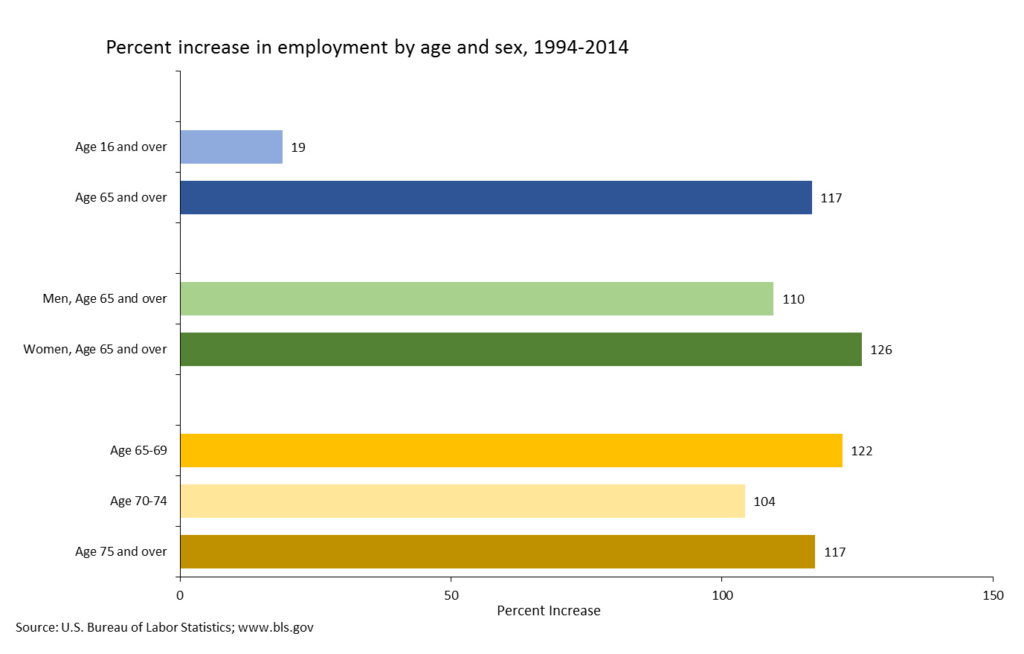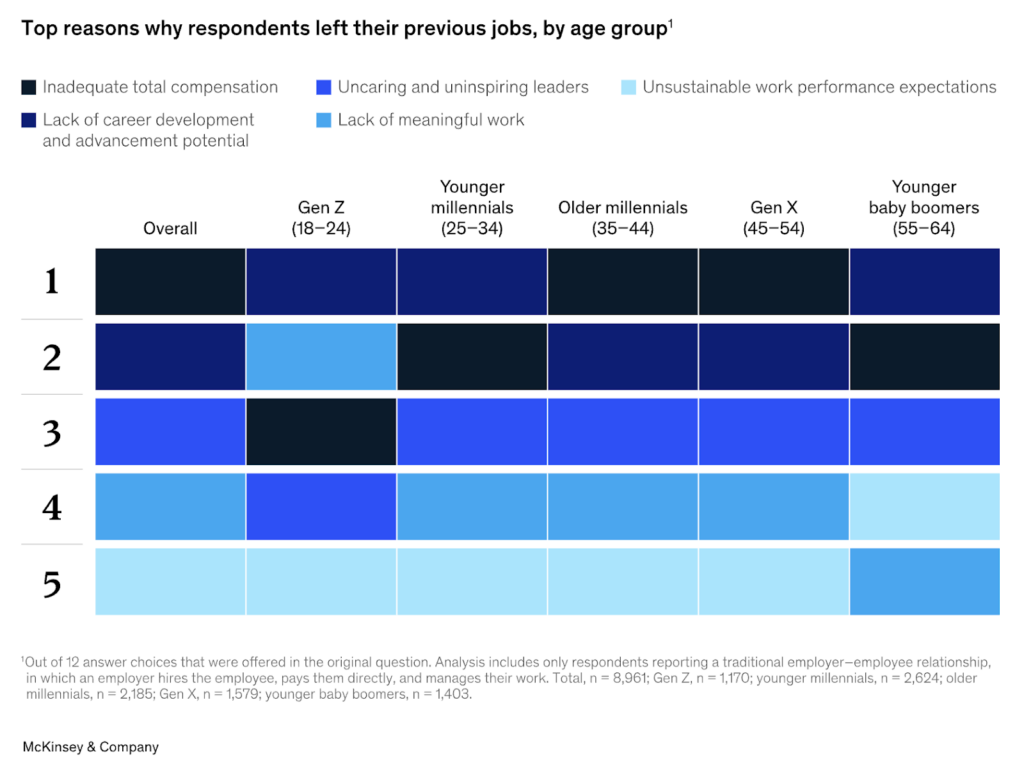If you order a meal at a certain restaurant in Tokyo, it’s not guaranteed that the food or beverage that is eventually brought to your table will be what you asked for.
That’s because this restaurant, The Restaurant of Mistaken Orders, only hires people with dementia.
The project was conceived to change stereotypes about dementia sufferers and their ability to work.
Despite the odd mistake, 99% of customers reported being happy with the experience overall. Indeed, the human connection is what draws people in.
Japan has one of the oldest populations in the world. It’s estimated that 3.8% of the population will be living with dementia in the mid-2030s, so it’s natural that a project such as this would crop up there.
But the world in general is aging and the workforce with it.
According to research by the US government, the share of employed workers over 60 in the U.S. doubled during the two decades between 2000-2020.

Numerous factors have contributed to this rise, not least of all that people are living longer, healthier lives.
Looking ahead, longer lifespans, combined with declining birthrates in the US and worldwide, will increase the median age of countries throughout the 21st century and there will be fewer young people entering the workforce.
Eventually, there will be fewer workers available overall, making the retention of top talent (young and old) even more vital.
A ‘graying workforce’, as some are calling it, poses various challenges for both policymakers and organizations.
An Aging Workforce: The Challenges
Ageism
In 5 years or so, Generation Alpha (those born after 2010) will begin entering the workforce.
This means that some organizations will have colleagues who witnessed the dawn of the information age and those who don’t know a world without smartphones.
The trap that’s easy to fall into here is making big generalizations about innovative, ‘tech-savvy’ Gen-Zers/Alphas vs Boomers and Gen-Xers stuck in their ways.
While there may be preferences and life experiences that define many within a specific age bracket, each generation is multi-faceted.
Not all of Generation Z are purpose-driven/work shy [insert adjective from recent thought leadership article]. For every older worker who may no longer be as career-driven as they once were, there will be another intently focused on personal development and progression.
“I think one of the biggest challenges of now having five generations working together is the very human tendency to stereotype and make generalizations about the traits and needs of an entire generation,” says Phil Burgess, Co-founder and Managing Partner at Within, “These groups are not monolithic and it’s important not to design strategies that define people solely by age.”
Recent McKinsey research found little difference between what people across the different generations want from work and why they decide to join or leave organizations.

While scientific evidence points to younger workers having an advantage over those who are older on raw brain power alone, workers across all age groups have a lot to offer. Older workers, with all their experience, will produce high-quality work and can act as mentors and coaches to younger generations.
“Basically, comparing an individual 20-something against an individual 60-something in raw output will usually result in the 20-something winning,” says Mark Varnas, Founder of tech consultancy Red9, “But that's seldom how workplace productivity actually functions. Knowledge and expertise are more essential than simply churning out as much information as possible.”
The old adage “work smart, not hard” comes to mind.
Absenteeism
Where older generations do generally differ is regarding health and responsibilities outside of work.
According to a study, Lost Work Time and Older Workers, by the Integrated Benefits Institute, older workers (those 55 and over) are more likely to suffer from health issues that keep them out of the workforce for longer and carry greater responsibilities in terms of caregiving. They’re also more likely to transition into long-term disability.
Factors such as this combine to increase the likelihood of older workers taking longer periods off to care for themselves or loved ones, which organizations that want to attract and retain older workers will need to accommodate.
How To Attract And Retain Older Workers
With the above challenges in mind, how can organizations accommodate an aging workforce and attract and retain the talent they need?
Provide flexibility
Workers old and young value flexibility around working hours and where they can work from.
This benefits older workers who may need to work around medical appointments and providing care.
But, as HR Leader Felicia Shakiba explains, “Flexibility in the workplace isn't just about schedules; it's about the fluidity of talent. For example, embracing part-time options for older workers allows them to share their decades of expertise and mentor, guide, and inspire the next generation. It's a testament to our commitment to nurturing a workforce where the wisdom of the past and the vigor of the future can coexist, creating a balanced, thriving, and intergenerational workplace.”
Christina Moran Ph.D., Operations Leader at ThenDesign Architecture, agrees, “Organizations and employees can benefit from exploring alternative roles such as trainers and other types of contributions that differ from how the more experienced employee served the organization before.”
So fire up your internal mobility programs and figure out how you can best leverage the skills of older workers!
For those who’ve taken time away from their career for whatever reason, a returnship program is a great way to ease experienced talent back into the workforce.
Foster inclusivity
DEI efforts extend to older workers as well. Of course, this means ensuring office spaces and equipment are designed to support older workers’ needs.
Further, as DEI expert Katie Zink explains, proper facilitation is vital too.
"Facilitation will be the most important skill set for people managers of all, but especially older generations. Good facilitation skills bridge interpersonal connection and simplify important information, particularly in remote environments. If managers are good facilitators, teams will widely benefit from the resources, knowledge and support across the organization in a non-hierarchical approach."
Other things to consider are facilitating the creation of employee resource groups to help better understand the needs of older workers and bias training—especially for managers and those conducting interviews.
Keep investing in learning and development
It’s generally believed that younger workers are hungrier to learn and develop in their careers.
While this is true, as Shakiba points out, “Education knows no age limit. Training and development opportunities keep the workforce evergreen, ensuring that the wisdom of the past aligns with the innovation of the future.”
Indeed, training older workers might just be a better investment overall. “Older workers generally move between jobs less, and early career folks can view L&D teams/programs as preparing them for the next stage in their career, where older workers see it as getting better at their job,” says L&D expert Eric Grant, “In many cases, this is actually more aligned with what L&D functions are meant to do.”
Fundamentally, though, training older workers still means ensuring your learning and development strategy is properly calibrated to assess workers’ current skills, identify skills gaps, and suppports the needs of the business and workers' preferences.
A formal mentoring program can help connect older and younger workers and share knowledge and experience. This can work both ways too.
“There's a less-discussed advantage in the realm of reverse mentoring. This practice is about enhancing the ability of younger workers to influence older employees who might be less inclined to change. In other words, it's an opportunity to refine their skills in gaining the trust and respect needed to teach older workers new methods and approaches—a valuable skill set in itself,” notes Shakiba.
Benefits and perks
Unsurprisingly, a study from the University of Iowa found that countries that spend more on healthcare generally have a fitter workforce across all ages.
In the absence of governments, organizations can offer benefits that appeal to older workers and help them remain working for longer.
In addition to the basics of health, dental, and vision, benefits expert Camila Menendez recommends these benefits as particularly useful for attracting and retaining older workers in the U.S.
- Supplemental health insurance
- Accident insurance
- Critical illness insurance
- Hospital insurance
- Being able to put Medicare-aged parents on their plan for their supplemental medical
- Health Savings Account
- Life insurance
- Short-term and long-term disability
- 401k
- Deferred retirement option plans (DROPS)
- Inclusive paid time off/paid leave.
Join The Conversation
How is your organization adapting to attract and retain older talent? Join the conversation in the People Managing People Community, a supportive community of HR and business leaders passionate about sharing knowledge and expertise to help you progress in your career and make impact in your organization.



